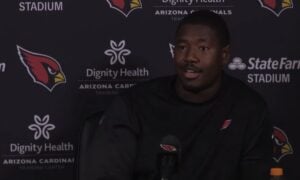It is safe to say that the Pittsburgh Steelers offense wasn\’t the same when quarterback Ben Roethlisberger returned to the lineup after sitting out three games due to injuries that he suffered in the week 10 win over the Kansas City Chiefs.
Team president Art Rooney II was looking for words during his Wednesday Q & A session with several members of the Pittsburgh media to describe what happened when Roethlisberger came back from his injury.
“The injury obviously changed things and we really never regained our rhythm or balance or whatever the right word is after the injury and when Ben came back,” Rooney said. “It’s a little hard to evaluate the whole season on that. When any team loses their starting quarterback, it has a dramatic effect. You have to evaluate in terms of when our quarterback was healthy. I think we were getting pretty good results and they were the results we hoped for.”
Was an injured Roethlisberger really part of the problem down the stretch, or was there something else that led to him having a 56.4% completion percentage in the final four games of the season?
“I’ll never make excuses,” Roethlisberger said, when asked prior to the final regular season game against the Cleveland Browns if he was still dealing with injury-issues down the stretch. “We can talk about that in the offseason maybe. I feel good enough to play.”
“It’s unfortunate,” the Steelers quarterback later continued. “Injuries are never fun. But you know me, I won’t make excuses. I’ve got to be able to step-up and perform afterwards just as well as I did before.”
Now I am sure that Roethlisberger wasn\’t 100% upon returning from his injury, but the 40 yard touchdown throw to Mike Wallace in the loss to the San Diego Chargers, his first game back mind you, was an absolute dart, and perhaps his single best throw all season.
That deep pass showed that Roethlisberger still could throw the deep ball, and as a matter of fact, he completed 4 of 15 throws of 20 yards or more past the line of scrimmage down the stretch for a 27% completion percentage. Prior to him getting injured he was 7 of 30 (23%) on throws of 20 yards or more past the line.
Not only was Roethlisberger more accurate with those long throws when he returned from his injury, he was also more accurate on his throws of 15 to 19 yards past the line of scrimmage, according to our play-by-play charting. Prior to his injury he was 18 of 38 (47%) on all throws of that distance and 11 of 17 (65%) upon his return.
So if Roethlisberger was better with the mid range to deep throws upon his return, then he must have suffered with his shorter throws, right? Right.
Prior to him getting injured he was 26 of 35 (74%) on his throws 10 to 14 yards past the line versus 14 of 24 (58%) upon his return. On his throws less than 10 yards he was 157 of 207 (76%) prior to his injury and 46 of 76 (61%) upon his return.
So why was there a drop-off in Roethlisberger\’s completion percentage on the shorter throws upon his return from injury? I think that he probable put it best following the loss to the Dallas Cowboys.
“They’re definitely keeping an eye on a lot of our short passes, the quick game, as we call it, because we’ve done a lot of it,” said Roethlisberger, when asked if defenses were starting to be more effective at disrupting the timing on short passes. “That’s how we started the year and we’ve been pretty successful at doing that stuff. They have sat on a lot of short routes, which means we need to take advantage of that, double-move and push the depth a little more.”
Left tackle Max Starks also hinted down the stretch in one of his interviews that defenses were playing more zone in addition. The tape shows this in those final four games, as well as more press coverage at times in addition. Thrown in on top of that is the fact that defenses did a good job at stopping the Steelers running game with only 7 men in the box a lot of the time. This allowed for more two deep safety looks that provided better bracket coverage.
The Steelers route combinations never compensated enough with vertical routes to counteract this and it didn\’t help that the receivers weren\’t gaining the separation that they did earlier in the season.
Defenses, on third down in particularly, did a much better job at protecting the chains on third downs as well. Remember the crucial third down play late in the game against the Cincinnati Bengals? On that play it is if the Bengals knew exactly what was coming their way.
Is all of this an indictment of offensive coordinator Todd Haley and his inability to adjust once defenses did a better job taking away the shorter passing game? Call it what you will, but I don\’t think that you can pin this on Roethlisberger being less than 100% when he returned from his injury. The amount of throws down the field increased some down the stretch, but not enough and the numbers are skewed a bit thanks to the loss to the Chargers, as they had no choice but to throw deep.
The Steelers offensive line was a mess down the stretch, so yes, that needs to be taken into consideration in all of this. Roethlisberger also made a few bad decisions as well in the three games that mattered and the running game was pretty much non existent.
Should Haley wind up not getting the head-coaching position with the Arizona Cardinals he will be back in Pittsburgh for chance to fix things. A priority will be to not only get the running game on track, but to also add more vertical elements to his offense to counteract the teams that insist on defending the Steelers the way that they did down the stretch this season. They likely won\’t have Wallace, who is all set to test free agency, to stretch the field in 2013, so you can expect the team will have to address his position at some point during the draft.
In the aforementioned quote that Rooney gave he said that the offense “never regained rhythm or balance or whatever the right word is.” The word that Rooney was looking for is, “adjusted”, as that is what the offense did very little of once Roethlisberger returned from his injury.
| ROETHLISBERGER BEFORE INJURY | ||||||
| DIST | COMP | INC | INT | ATT | COMP % | % ATT |
| 20+ | 7 | 20 | 3 | 30 | 23% | 9.7% |
| 15 – 19 | 18 | 20 | 0 | 38 | 47% | 12.3% |
| 10 to 14 | 26 | 9 | 0 | 35 | 74% | 11.3% |
| less than 10 | 157 | 49 | 1 | 207 | 76% | 66.8% |
| ROETHLISBERGER AFTER INJURY | ||||||
| DIST | COMP | INC | INT | ATT | COMP % | % ATT |
| 20+ | 4 | 10 | 1 | 15 | 27% | 11.4% |
| 15 – 19 | 11 | 6 | 0 | 17 | 65% | 12.9% |
| 10 to 14 | 14 | 9 | 1 | 24 | 58% | 18.2% |
| less than 10 | 46 | 28 | 2 | 76 | 61% | 57.6% |







